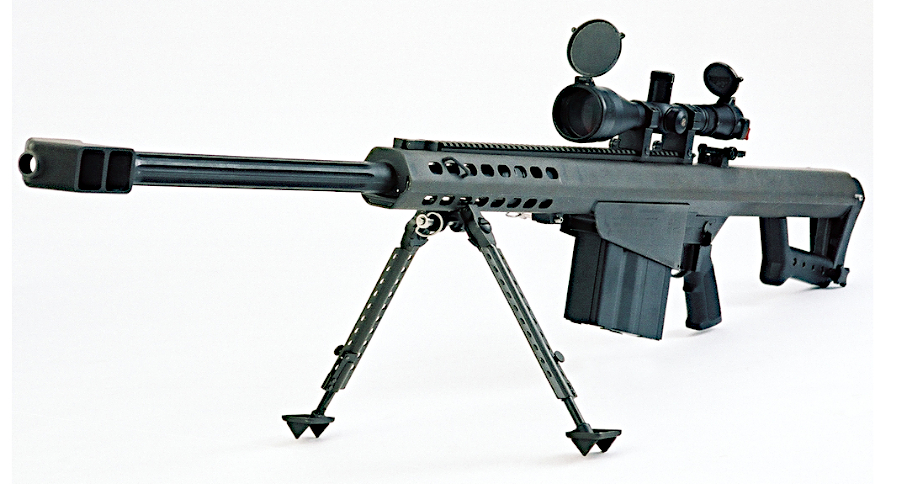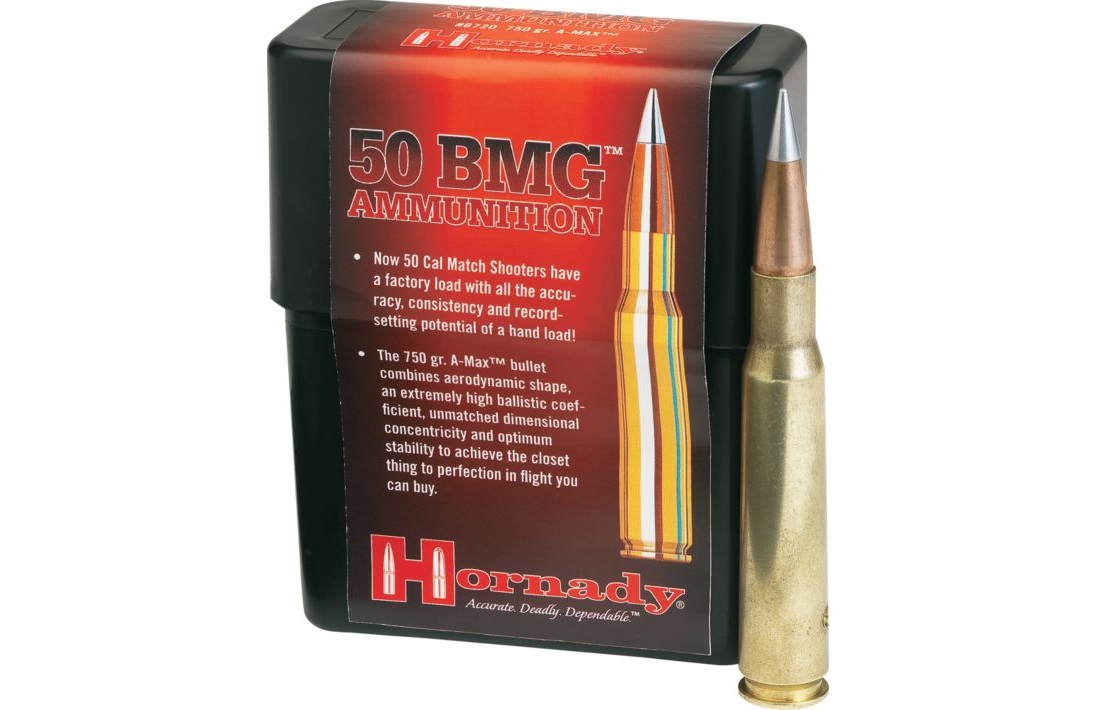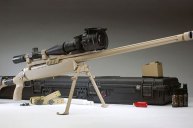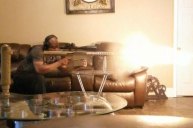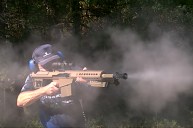The iconic Barrett 50 cal has cemented a place in firearms history.
Almost every major firearms development in the United States has come from someone who has a crazy dream. That is the case with Barrett rifles. The development of the Barrett Model 82 is a true American success story. This long-range weapon is now one of the most recognizable firearms on the planet and is in heavy use by the U.S. Military. In fact, it has become the stuff of legend at this point. Even though it has only been in service for around 40 years, it is safe to say the Barrett name is now as recognizable as Remington, Springfield Arms, Browning or Garand.
Barrett is the reason the 50 BMG has taken off as a round used by soldiers and shooting enthusiasts the world over.
This is the story of Barrett Firearms Manufacturing. Along the way we will tell you everything you ever wanted to know about these semi-automatic rifles.
A brief history of Barrett Firearms
When you consider all the military and law enforcement contracts the company has, you might think the M82 was in development for decades with a dedicated group of firearms designers. The truth is far wilder.
Ronnie Barrett was not even in the firearms industry when he had the idea for the first Barrett 50-caliber rifle. He was a photographer. He was shooting photos of a historic gunboat near Nashville, Tennessee sometimes in the early 80s. By chance, the gunboat was fitted with two Browning M2 machine guns, which at the time, were some of the only firearms that utilized .50 cal ball ammo.
The Browning M2 is an unwieldy weapon at nearly 83 pounds. That is why it is usually mounted on ships, tanks and trucks. However, Barrett saw there was a hole in the market for a lighter, more precise rifle in the caliber. The only problem was, he had zero engineering experience. Undeterred, he drew up his idea for the rifle and took it to several machine shops, which promptly laughed him out the door.
Like many great innovations, Barrett's idea was ahead of its time. Let this next part of the story serve as a lesson to always follow your dreams. Because, after much determination, Barrett eventually found one tool and die maker, Bob Mitchell, who saw Barrett's vision clearly. The two immediately began working on a prototype. It may surprise some firearms enthusiasts to learn that the first Barrett rifles were developed in Barrett's garage. They did this while continuing to work their full-time jobs!
It took a while for Barrett's design to catch on. At first, they sold the rifles directly through ads and at gun shows. However, it did not take long for government agencies and armed forces to take notice. His first military sale was to Sweden in 1989. That opened the flood gates.
One year later, the United States was involved in the first Gulf War and the first Barretts were purchased for use in Iraq by the U.S. Marine Corps. Other branches including the U.S. Army and Navy took notice and soon followed. The firearm has been involved in almost every major conflict since. Ronnie Barret's amazing success story is truly one that could only happen in America!
The Barrett M82
There are a few different Barrett rifles that have played vital roles in the military, but we are only going to focus on two here today. The original Barrett is the M82, a short recoil-operated, rotating bolt rifle. If you watch one of these firing in slow-motion, you will see that the barrel helps cycle the rounds by moving backwards after each shot. The huge magazines hold 10 rounds, often incendiary or armor-piercing rounds. This gun can produce a staggering 10,000-14,000 foot pounds of energy. This results in blistering bullet speeds of up to 2,800 feet per second!
Manufacturer specs say this rifle has an effective range of 2,000 yards, but many of the world's top snipers have pushed this rifle far beyond that. For instance, in 2012, an Australian sniper scored a confirmed kill with the Barrett M82A1 at 3,079 yards! The longest confirmed sniper shot by an American was also with a Barrett. In October of 2004, U.S. Army Ranger, Sgt. Brian Kremer used one in Iraq to make a confirmed kill at 2,515 yards.
There are a few different variants on the M82, but the one that civilians can buy is the Barrett Model 82A1, which is also probably the one most widely used by armed forces around the world. This beast of a rifle has a 20 or 29-inch barrel length with either a 1:15 or 1:12 rate of twist. The overall length is a ridiculous 57 inches and the whole package weighs 33 pounds. The company offers the rifle in a variety of finishes including black, tungsten gray, burnt bronze and flat earth cerakote,
Most of that weight comes from the heavy sheet metal assembly for most of it. The rifle must be heavy to handle the powerful forces and kinetic energy being delivered by the round. The fluted barrel, huge muzzle brake and springs do help with taming some of the Model 82A1's felt recoil, but make no mistake, the Barrett has some serious kick to it.
This gun is also fitted with a bipod that can be quickly attached and detached. A grip handle helps with carrying this heavy gun. Most people are going to mount a large scope on an M82, but these rifles also have flip up iron sights. These are obviously meant to be used a backup, but they are effective when needed.
Barrett M107A1
The U.S. Army formally adopted the M107A1 in 2002. The big difference between this semi auto rifle and the M82 is simply in the weight. They accomplished this by changing to aluminum for the receiver and other parts of the frame. Barrett also made many of the parts out of titanium, including the detachable bipod. Through more precision engineering, Barrett also claims the M107 is more accurate than the M82.
The company also cut weight with a smaller muzzle brake on the 20 or 29-inch barrels. The big plus to this brake over the old design is that it is already built to accept a suppressor which should help with the loud noise and felt recoil. Many of the other features of this rifle are the same. It also uses 10-round magazines and it usually reaches the same muzzle velocities of the M82.
This rifle is sometimes called "The Light Fifty," which as any soldier will tell you, is something of a misnomer. Barrett did manage to shave about four pounds off the newer design, but it is still quite hefty at 28.7 pounds unloaded. However, that is to be expected with a BMG rifle of this size.
What is a Barrett 50 used for?
Many people misunderstand the practical use of Barrett .50 cals. These rifles are largely believed to be sniper rifles. You can thank Hollywood and dozens of inaccurate portrayals of this gun in film for that. While they are used for that purpose, anti-personnel was not the original intent when many militaries purchased them. The Barrett 50 BMG is an anti-material rifle. It was originally meant to punch through armor and destroy vehicles and other military hardware. That is why you will see so many armor piercing and incendiary rounds. These rounds can be used to easily disable aircraft and vehicles
In some cases, the Barrett has also been used to dispose of explosive devices from a distance. One shot will destroy potential traps and help keep troops safe. Sniper rifles have traditionally been bolt action rifles because those provide better accuracy, so the army was not even really thinking of the Barrett for that purpose at first.
However, soldiers quickly discovered how useful the Barrett was for different combat scenarios. The 12.7x99mm NATO rounds were good at taking out vehicles, but they were even better for taking out snipers or punching through walls to take out dug-in enemy combatants. The gun could accomplish this from ranges that enemy guns were completely ineffective. This helped bring more troops home safely. While most snipers do not use Barretts exclusively, their use among snipers does seem to be more common now than when these rifles were first introduced.
How much does a Barrett 50 cal cost?
It may surprise some people to learn that owning this incredible piece of military hardware is perfectly legal in most states. The Barrett .50 cal does not fall under NFA regulations. Although it is worth noting there are certain areas of the country that have banned them outright. If you already owned one pre-ban in California, you are good to go, but it should not surprise you to learn that the Golden State does not allow any new sales. That is par for the course for California.
Connecticut bans the M82A1 outright and other states may impose additional regulations with the purchase of these firearms. Everywhere else is open for sale. The only downside is the price.
For most people, a Barrett is not the type of gun that is an impulse purchase at the gun shop while on your way home from work one day. Of the two we have talked about here today, the 82A1 is the cheaper option. You can expect to pay anywhere from $6,000-$10,000 for one depending on the gun broker.
If you want the newer M107, expect to open the wallet even wider for that one. It is not uncommon to pay $10,000-$12,000 for one. Keep in mind that is often without an optic! In my research for this article, the cheapest M107 I found online started at just over $7,000 and the most expensive started at $13,000. There is a reason most people do not have one of these guns in their cabinet!
How much is a Barrett 50 cal bullet?
While the price of the Barrett .50 BMG may seem intimidating, for some people it is a must-have. Just be prepared for the high cost of ammo that comes with it. Factory loads are among the most expensive that the average citizen can buy. Expect to pay between $5-$7 a round! If you are talking specialty rounds like incendiary, the cost may be as much as $10. We can feel the hit to the wallet every time we take a single shot. That means at a minimum, just 10 rounds will cost you around $50. It is not uncommon for a 10-round box to cost nearly $70.
Most Barrett enthusiasts get into reloading ammo out of necessity. Obviously, the setup for reloading .50 BMG is another large cost, but we have heard of reloaders being able to drastically cut costs. Make no mistake, it still is not cheap. The primers are the most expensive component. However, if you can even cut the costs per round in half, you will be able to enjoy shooting your rifle more than factory loads.
For more outdoor content from Travis Smola, be sure to follow him on Twitter and check out his Geocaching and Outdoors with Travis YouTube channels.
NEXT: MAN SHOOTS .50 CAL IN LIVING ROOM AGAIN, THIS TIME WITH NO SUPPRESSOR
WATCH
